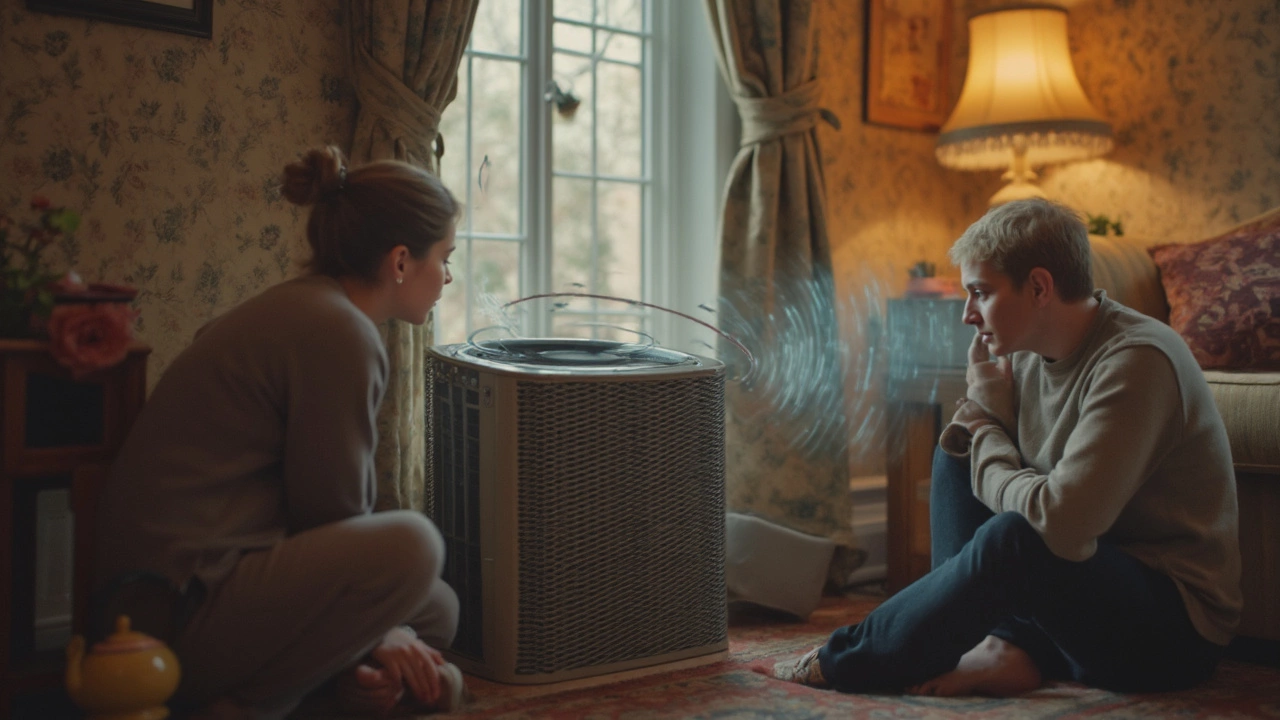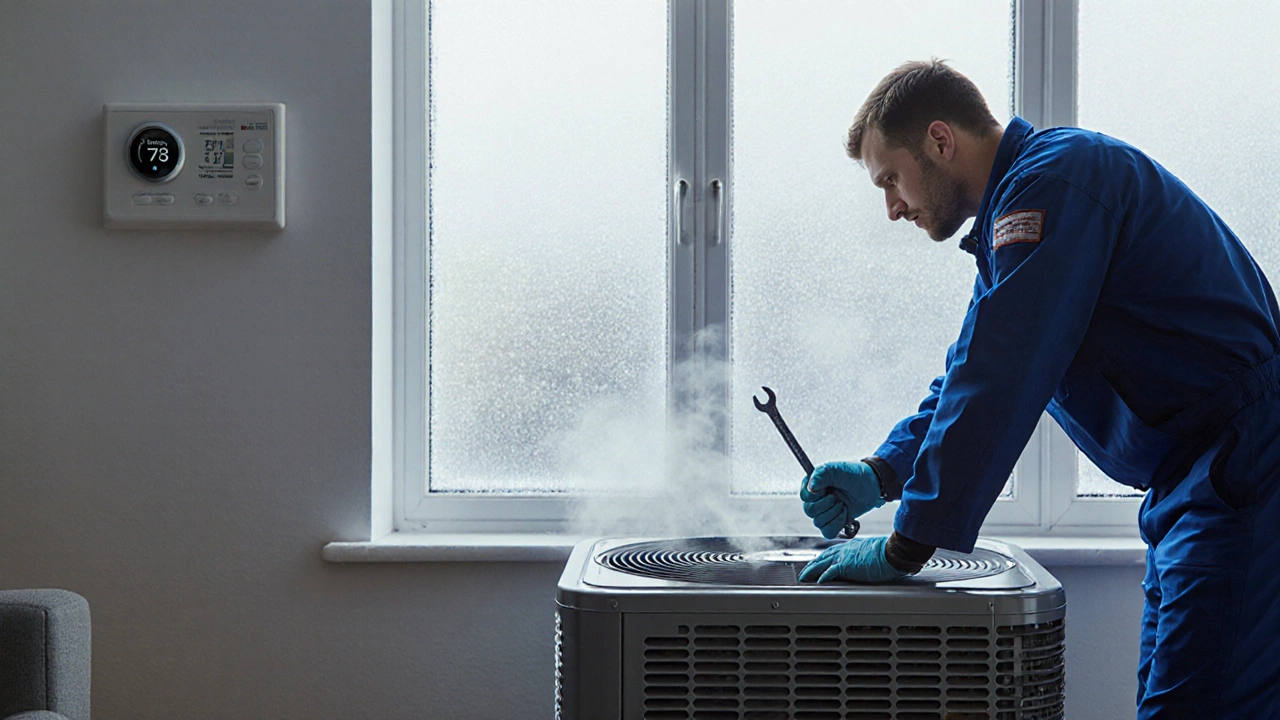
- 30 Mar 2025
- Gideon Thornton
- 0
No one wants to wake up to a chilly home when the heat pump decides to call it quits. You know how it is—one moment it's all warm and cozy, and then boom! Your house feels like the inside of a fridge. So, how can you tell if your heat pump is playing tricks on you? Keep an ear out for weird noises like grinding or squealing—that's not normal, and it's your heat pump's way of saying something's off.
Have you noticed cold spots in your living room when it should be warm and toasty? That's another red flag. A heat pump should provide consistent temperatures, not make you feel like you're moving from a sauna to the Arctic. And then there's the energy bill. If it's shot up faster than a rocket and you're scratching your head, it's time to investigate. Efficient systems shouldn't burn a hole in your wallet.
- Recognizing Weird Noises
- Spotting Inconsistent Temperatures
- Tracking Energy Efficiency
- Noticing Short Cycling
- Understanding Frozen Coils
- Knowing When to Call a Professional
Recognizing Weird Noises
Picture this: You're sitting in your living room, enjoying a quiet evening, when suddenly your heat pump starts making noises that sound like a construction site. Weird, right? Unusual sounds are often a clear sign that something's up. But what do they mean? Let's break it down.
First off, a grinding noise might signal that the motor's bearings are shot. If you hear something that reminds you of grinding gears, it might be time to think about a professional check-up. Ignoring this can lead to even bigger headaches down the road.
Then there's the high-pitched squeal. It's as annoying as nails on a chalkboard, right? This could mean a belt is loose or worn out. While it might sound like a minor issue, a broken belt can halt the whole system, leading to pricier repairs.
- Rattling Sounds: Often caused by loose parts. Tightening them might solve the problem temporarily, but a service technician should inspect it soon.
- Banging or Clunking: This could mean the interior parts are off balance, which can wear them down faster. It needs attention before it worsens.
- Buzzing: Possible electrical issues. Don’t ignore this, as electrical faults are both safety concerns and potential system killers.
If your heat pump suddenly turns into a noisy neighbor, it’s shouting for help. Listening to it might save you from unexpectedly cold nights and hefty repair bills. Always consider calling a professional if these noises persist, especially for any potential HVAC issues that you can’t fix yourself. Trust me, your peace of mind and your wallet will thank you.
Spotting Inconsistent Temperatures
So, your heat pump is supposed to keep your home feeling just right, but if you're noticing that your living room feels like a sauna while your bedroom is like a freezer, something's off. Inconsistent temperatures are a classic sign that your heat pump might be slacking off.
A properly working heat pump should help distribute heat evenly across your home. If that's not happening, you might be facing an issue with airflow. Sometimes, dirt and dust build-up can block the vents or the filter could be clogged, making your system work extra hard (and less efficiently).
Another potential culprit could be a refrigerant leak. If there's not enough refrigerant, your HVAC system can't transfer heat effectively, leading to those pesky hot and cold spots. A trained professional should handle refrigerant checks and repairs, as it's not really a DIY job.
Also, take a look at your thermostat settings. Is it outdated? Sometimes a simple upgrade to a smart thermostat can solve these issues, giving you more control and consistency in home temperatures.
The bottom line is that keeping an eye on temperature fluctuations can help you catch heat pump issues early. It'll save you from those cold surprises and keep your energy bills from spiking unexpectedly.
Tracking Energy Efficiency
Have you ever felt like your energy bill is climbing faster than a rollercoaster ride? It could be a sign that your heat pump is working overtime. But how do you know for sure? Well, let's break it down.
First off, energy efficiency is all about how well your heat pump converts electricity into heating or cooling your home. If your system isn't efficient, it needs more power to do its job, which means more bucks out of your pocket.
One simple way to keep tabs on this is by checking your energy bills month-on-month. If you notice a sudden spike and you haven't changed your lifestyle—like using more appliances or cranking up the heat—your heat pump might be the culprit.
Besides the bills, pay attention to how often the heat pump cycles on and off. Frequent cycles mean it might be struggling to maintain the temperature, resulting in extra energy use. This issue, known as short cycling, can wear down your unit faster than usual.
To dig even deeper, some folks use smart thermostats. These nifty devices give you detailed reports of your energy consumption patterns. They’re like having a personal accountant for your electricity use.
Sometimes, checking the efficiency involves looking at the unit's Seasonal Energy Efficiency Ratio (SEER) or Heating Seasonal Performance Factor (HSPF). Higher ratings mean better efficiency. Here's a little stat for you:
| Efficiency Rating | Description |
|---|---|
| 14-16 SEER | Standard modern efficiency |
| 18 SEER+ | Considered high efficiency |
If these numbers are a mystery, it’s smart to have a professional check your system. They'll make sure everything's running as smoothly as your favorite playlist on a Saturday night.
In short, keeping an eye on your energy efficiency not only saves cash but also prevents wear and tear on your system. Plus, who doesn't love a lower energy bill?

Noticing Short Cycling
Okay, let's talk about something called short cycling. It sounds like a biking term, but it’s actually a heat pump issue. Short cycling happens when your heat pump turns on and off more frequently than it should. This is a big red flag. Why? Because it’s not just annoying; it's a sign that your heat pump might be malfunctioning.
When your heat pump is experiencing short cycles, it can’t complete a full heating or cooling cycle. Imagine trying to bake a cake but turning the oven off every few minutes. That cake’s gonna be a disaster, right? Same idea here! Frequent on-off cycling means your home doesn’t stay at the temperature you want, and it throws efficiency out the window.
Several things could be causing this short cycling. A common culprit is a thermostat placed where sunlight hits directly. It ends up thinking your room is warmer than it is, flipping the pump on and off like a switch. Clogged air filters can also choke the system's airflow, making the pump overwork itself to maintain your desired temperature.
- Check your thermostat's position. Make sure it's not getting direct sunlight.
- Inspect your air filters regularly and swap them out if they’re looking like a neglected dust collector.
- If DIY checks don't solve the issue, it might be time to reach out to a professional.
Now here’s a kicker: short cycling can hike up your energy costs (ouch!) and shorten the life of your heat pump. Nobody wants that kind of extra expense. It's crucial to get on top of this situation quickly to avoid higher bills and prevent bigger issues down the line.
Understanding Frozen Coils
Ever noticed your heat pump is covered in ice, looking more like a popsicle than a heating solution? That's a classic sign of frozen coils, a common issue that can mess with the efficiency of your HVAC system. When the evaporator coils freeze, it usually means something's not right with airflow or the refrigerant levels.
First things first, a variety of things can cause those coils to freeze. The most common culprit? Dirty air filters. When filters are clogged, airflow drops, causing the temperature inside the unit to fall to freezing levels. So, make sure you're keeping those filters clean. It's a simple thing, but it does wonders.
Low refrigerant can also cause the coils to ice up. It’s like trying to run your car with no gas—it just won’t work right. If you suspect this might be the issue, it's best to call a pro to check those refrigerant levels and fix any leaks in the system.
Another thing to look out for is the thermostat setting. Cranking it too low can make the coils work overtime, leading to those pesky ice buildups. Sometimes just readjusting the settings can save you a world of hassle.
Want to know how often this happens? Around 30% of heat pump issues reported by homeowners are due to frozen coils. If you ever notice ice forming, check these points:
- Inspect the air filters and replace them if needed—keeping them clean keeps the air flowing smoothly.
- Ensure the outdoor unit isn't blocked by debris. Clear leaves, dirt, and any obstructions to improve airflow.
- Look at the settings to ensure your thermostat isn’t set too low.
- Contact a technician for a professional check-up on refrigerant levels and potential leaks.
Don't ignore the signs of heat pump problems. Frozen coils might seem like a minor issue, but they can lead to greater damage if not addressed. By staying on top of these things, you'll save yourself money and a whole lot of stress.
Knowing When to Call a Professional
Sometimes, trying to fix a heat pump on your own might seem tempting, especially if you're the hands-on type. But there are moments when it's best to bring in the pros. Here's how you can tell when it's time to reach for the phone instead of the toolbox.
First off, if you've checked the basics—like ensuring the thermostat is set correctly or changing filters—and the heat pump problems persist, it's definitely time for expert help. Professionals have the tools and knowledge to fix even the hidden issues that aren't obvious to the untrained eye.
Another sign that you should leave it to a professional is if your heat pump is malfunctioning by short cycling—when it turns on and off too frequently. This can be due to various reasons, like electric issues or refrigerant leaks, both of which require technical skills and safety precautions you shouldn't try at home.
Odd smells, especially those that seem like something's burning, are a huge no-no. These can indicate electrical issues that are not only harmful to your heat pump but dangerous for your home. You don't want to take your chances with that kind of risk.
If you've noticed inefficient heating despite doing everything you can, or if you see ice on the coils that's more than normal frost, it's time for a professional intervention. These problems could require more complex repairs or even component replacements.
Here’s a little perspective with some numbers. According to a 2024 report by the HVAC Safety Institute, regular professional maintenance can extend the life of your heat pump by 5 to 10 years, ensuring efficient operation and reducing emergency repair costs.
Ultimately, whenever safety is in question or a DIY repair might void your warranty, call a reputable technician. They not only fix problems but can help you spot potential future issues. This way, you'll get the peace of mind that everything is running smoothly and efficiently.



